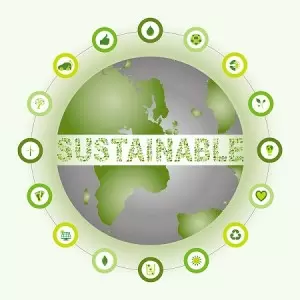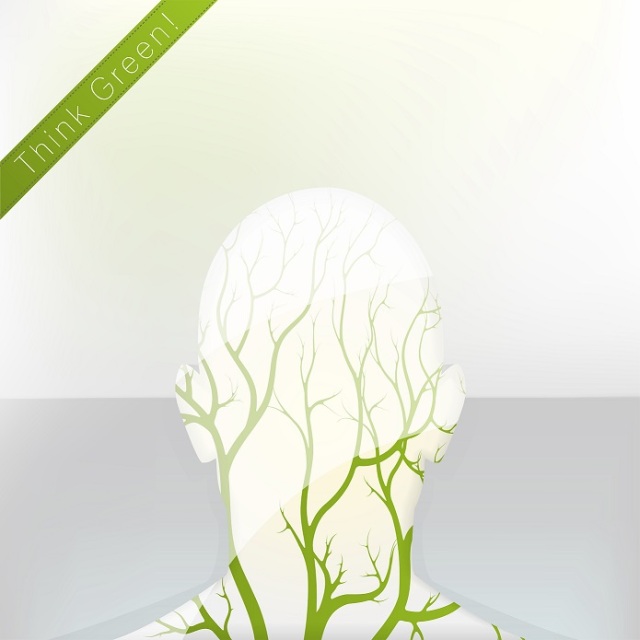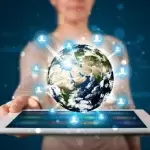
Sustainability is a broad discipline, giving students and graduates insights into most aspects of the human world from business to technology to environment and the social sciences.
Define Sustainability
The definition of “sustainability” is the study of how natural systems function, remain diverse and produce everything it needs for the ecology to remain in balance. It also acknowledges that human civilization takes resources to sustain our modern way of life (1). There are countless examples throughout human history where a civilization has damaged its own environment and seriously affected its own survival chances (some of which Jared Diamond explores in his book Collapse: How Complex Societies Choose to Fail or Survive (10)). Sustainability takes into account how we might live in harmony with the natural world around us, protecting it from damage and destruction.
Balancing Resource Use for a Greener Future
We now live in a modern, consumerist and largely urban existence throughout the developed world, and we consume a lot of natural resources every day. In our urban centres, we consume more power than those who live in rural settings (2, p3-4) and urban centres use a lot more power than average, keeping our streets and civic buildings lit, to power our appliances, our heating and other public and household power requirements. That's not to say that sustainable living should only focus on people who live in urban centres though, there are improvements to be made everywhere - it is estimated that we use about 40% more resources every year than we can put back and that needs to change (3, p2). Sustainability and sustainable development focus on balancing that fine line between competing needs - our need to move forward technologically and economically, and the needs to protect the environments in which we and others live.
Sustainability is not just about the environment (4), it's also about our health as a society in ensuring that no people or areas of life suffer as a result of environmental legislation, and it's also about examining the longer term effects of the actions humanity takes and asking questions about how it may be improved (2).
History of Sustainability
Humans have, since the Neolithic Agricultural Revolution and maybe even before then, been a consumer rather than a replenisher of environmental resources. From hunter-gatherer societies that moved into an area to use up its resources in a season before setting up camp or moving on, only to return the following year to do the same, the development of a surplus economy saw permanent settlements. Slash and burn farming replaced natural wilderness often with uniform crop plantation (11, p2483) and camps gave way to settlements, then eventually villages, towns and cities which would put pressure on the environment.
Sometimes, the environmental pressures forced people into making these changes in the first place (growing human population being one of those pressures) and often eventually they had to move on to somewhere new where the environmental could better sustain them and their practices, or make further changes to their existing environment. There was no real concept of sustainable living, even if the people of the distant past understood that soil had a maximum fertility that could be exhausted and replenished with livestock.
It is widely acknowledged that many societies collapsed due to an inability to adapt to the conditions brought on by these unsustainable practices (10). Whether that was introducing alien species that upset the balance of the ecosystem, cutting down too many trees at once or even a failure to adapt to natural fluctuations in the climate, we are far more aware in the modern world about the potential damage caused by human action. Cultural change often led to survival of those societies beyond what might have been expected under the circumstances (11, p2485).
Though some Renaissance and Enlightenment philosophers would express concern about resources and over-population and whether these were sustainable in the long term, these people were not taken seriously at the time other than as a hypothetical question. It would take until the 20th century before we would understand the impact that we could have on our environment. Environmental damage, pollution, destabilizing soils by cutting down trees, fossil fuels and other environmental issues led to a growing concern about the environment and whether we were or could damage our own ecosystem. The United Nations was founded after World War II and in 1945, UNESCO was established to promote the importance of human culture and of science (14). Today, their remit is "to contribute to the building of peace, the eradication of poverty, sustainable development and intercultural dialogue through education, the sciences, culture, communication and information" (15).
By the late 20th century, the science of climate change was firmly established. We knew by the 1980s about the problems of the greenhouse effect and the destruction of the ozone layer (12) and coming very late in the century, an awareness of the notion that some of our resources - particularly fossil fuels - were finite and that we should make efforts to move to renewable methods of power. It was then that we saw the social, economic and scientific birth of the environmental movement.
The Three Pillars of Sustainability
In 2005, the World Summit on Social Development identified three core areas that contribute to the philosophy and social science of sustainable development. These “pillars” in many national standards and certification schemes, form the backbone of tackling the core areas that the world now faces. The Brundtland Commission described it as “development that meets the needs of the present without compromising the ability of future generations to meet their own needs" (6). We must consider the future then, in making our decisions about the present.
Economic Development
This is the issue that proves the most problematic as most people disagree on political ideology what is and is not economically sound, and how it will affect businesses and by extension, jobs and employability (2, p4). It is also about providing incentives for businesses and other organizations to adhere to sustainability guidelines beyond their normal legislative requirements. Also, to encourage and foster incentives for the average person to do their bit where and when they can; one person can rarely achieve much, but taken as a group, effects in some areas are cumulative. The supply and demand market is consumerist in nature and modern life requires a lot of resources every single day (6); for the sake of the environment, getting what we consume under control is the paramount issue. Economic development is about giving people what they want without compromising quality of life, especially in the developing world, and reducing the financial burden and “red tape” of doing the right thing.
Social Development
There are many facets to this pillar. Most importantly is awareness of and legislation protection of the health of people from pollution and other harmful activities of business and other organizations (6). In North America, Europe and the rest of the developed world, there are strong checks and programs of legislation in place to ensure that people's health and wellness is strongly protected. It is also about maintaining access to basic resources without compromising the quality of life. The biggest hot topic for many people right now is sustainable housing and how we can better build the homes we live in from sustainable material. The final element is education - encouraging people to participate in environmental sustainability and teaching them about the effects of environmental protection as well as warning of the dangers if we cannot achieve our goals (7, p7-12).
Environmental Protection
We all know what we need to do to protect the environment, whether that is recycling, reducing our power consumption by switching electronic devices off rather than using standby, by walking short journeys instead of taking the bus. Businesses are regulated to prevent pollution and to keep their own carbon emissions low. There are incentives to installing renewable power sources in our homes and businesses. Environmental protection is the third pillar and to many, the primary concern of the future of humanity. It defines how we should study and protect ecosystems, air quality, integrity and sustainability of our resources and focusing on the elements that place stress on the environment (6). It also concerns how technology will drive our greener future; the EPA recognized that developing technology and biotechnology is key to this sustainability, and protecting the environment of the future from potential damage that technological advances could potentially bring (1).
What are the Primary Goals of Sustainability?
The sustainable development professional network thinks, acts and works globally.
In 2012, the United Nations Conference on Sustainable Development met to discuss and develop a set of goals to work towards; they grew out of the Millennium Development Goals (MDG) that claimed success in reducing global poverty while acknowledging there was still much more to do. The SDG eventually came up with a list of 17 items (8) which included amongst other things:
- The end of poverty and hunger
- Better standards of education and healthcare - particularly as it pertains to water quality and better sanitation
- To achieve gender equality
- Sustainable economic growth while promoting jobs and stronger economies
- All of the above and more while tackling the effects of climate change, pollution and other environmental factors that can harm and do harm people's health, livelihoods and lives.
- Sustainability to include health of the land, air and sea
Finally, it acknowledged the concept of nature having certain rights - that people have stewardship of the world and the importance of putting people at the forefront of solving the above global issues (9) through management of the environment and of consumption (for example, reducing packaging and discouraging food waste as well as promoting the use of recyclable materials).
Essential Skills for Sustainability Graduates
The core skills with which environmental science graduates leaves college or university are highly sought after, especially in a modern world looking to drastically reduce carbon emissions and discover and develop the technologies of the future. Sustainability draws on politics, economics and, philosophy and other social sciences as well as the hard sciences.
Sustainability skills and environmental awareness is a priority in many corporate jobs at graduate level and over as businesses seek to adhere to new legislation. Therefore, Sustainability graduates will go into many fields but most commonly civic planning, environmental consultancy (built and natural environment), agriculture, not for profit, corporate strategies, health assessment and planning, and even into law and decision making. Entry-level jobs are growing and over the coming years, bachelors graduates can expect more and more options and opportunities.
Bachelor's Degrees in Sustainability: A Gateway to Diverse Opportunities
Sustainability is one the newest degree subjects that attempts to bridge social science with civic engineering and environmental science with the technology of the future. When we hear the word “sustainability” we tend to think of renewable fuel sources, reducing carbon emissions, protecting environments and a way of keeping the delicate ecosystems of our planet in balance. In short, sustainability looks to protect our natural environment, human and ecological health, while driving innovation and not compromising our way of life. Because of this growing requirement, a master's will not necessarily be required for most jobs as bachelor's programs (and in some cases lower than this) prepares people for a career in sustainability. Read more about the various sustainability degrees and education.
A Sustainable Future
It is not yet clear what our sustainable future will look like but with emerging technologies and the improvement of older cleaner fuel sources, many people now look to a post fossil fuel world - including businesses. Since the 1950s, we have experienced unprecedented growth including intensive farming, a technological revolution and a massive increase in our power needs (13, p2) putting even greater pressure and strain on the planet's resources. We are also far more aware of the plight of the developing world and that facing our planet as we now observe both natural and human-caused disasters and the effects that these can have on the ecosystems and on human population. It's vital that we develop new, cleaner technologies to cope with our energy demands but sustainability is not just about the environment.
The biggest social activism movement related to the social development side of sustainability, has been programs such as Fair Trade and the Rainforest Alliance in encouraging good farming practices while ensuring farmers who produce luxury goods such as coffee and cocoa receive a decent living wage (14). Activist and sustainability professionals hope to remove trade barriers in future so that they may benefit everyone, contributing to the economic and social development core of sustainability while promoting good environmental practice (16).
Sources
- http://www.epa.gov/sustainability/basicinfo.htm
- https://www.academia.edu/9294719/Urban_Sustainability_in_Theory_and_Practice_Circles_of_Sustainability_2015_
- http://degrowth.org/wp-content/uploads/2011/05/Lorek_Sustainable-consumption.pdf
- http://www.sd-commission.org.uk/pages/what-is-sustainable-development.html
- http://epa.gov/ncer/rfa/forms/sustainability_primer_v7.pdf
- https://www.iucn.org/resources/publication/future-sustainability-have-your-say
- https://www.sustainabilityconsortium.org/2011/03/new-white-paper-social-sustainability-assessment/
- https://sustainabledevelopment.un.org/content/documents/4538pressowg13.pdf
- https://sustainabledevelopment.un.org/focussdgs.html
- Diamond, J. 2005: Collapse: How Complex Societies Choose to Fail or Survive. New York: Penguin (http://cpor.org/ce/Diamond%282005%29Collapse-HowSocietiesChooseFailureSuccess.pdf)
- http://www.pnas.org/content/106/8/2483.full.pdf+html
- http://assets.panda.org/downloads/living_planet_report_2008.pdf
- http://www.histecon.magd.cam.ac.uk/history-sust/files/Big_Here_and_Long_Now-presentation.pdf
- http://www.rainforest-alliance.org/work/agriculture
- http://www.unesco.org/new/en/unesco/about-us/who-we-are/introducing-unesco/
- Guide to Parasitology - November 19, 2018
- Deserts as Ecosystems and Why They Need Protecting - November 19, 2018
- Conservation: History and Future - September 14, 2018
Related Articles
Featured Article

Recommended Environmental Science Articles & Journals





